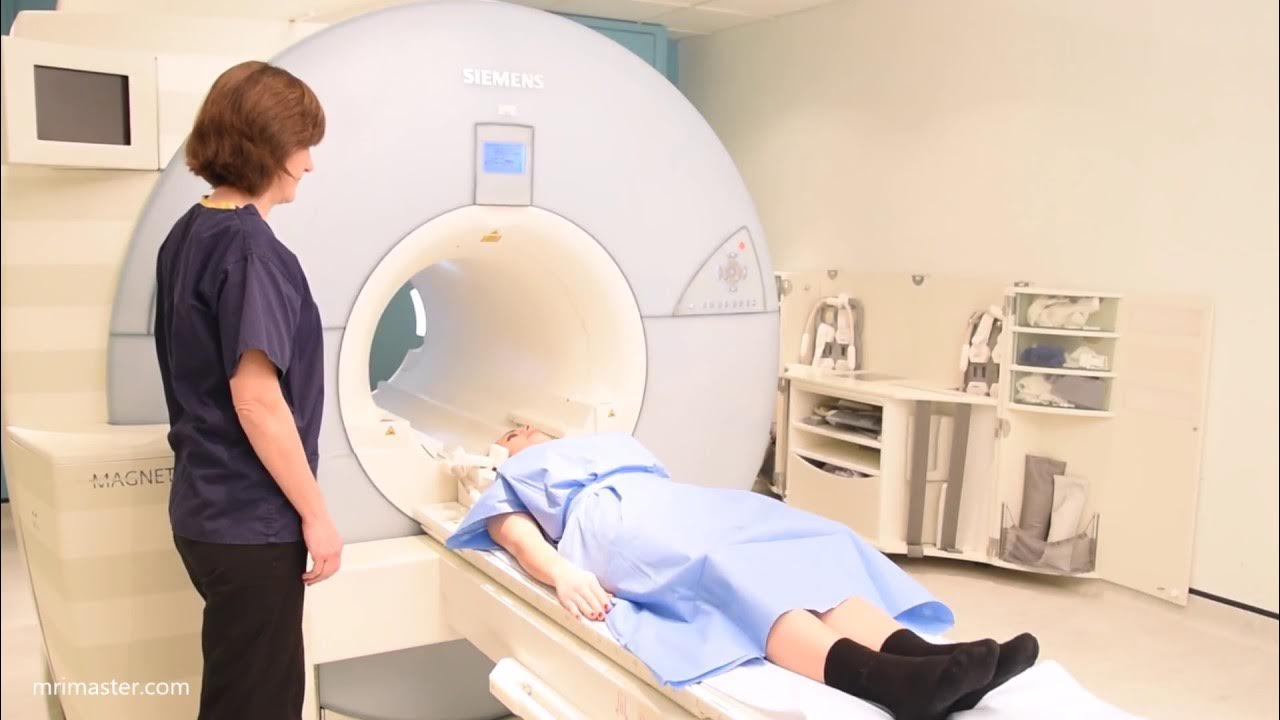IAC’s
Summary
TLDRThis video script outlines the detailed process of conducting a series of MRI scans, focusing on the brain, with specific emphasis on the steps and techniques used for precise imaging. It covers various sequences like the axial, T1, T2, and Fiesta scans, including how to adjust parameters such as slice thickness, angle, and TR settings. The process is methodical and involves ensuring optimal alignment and contrast for clear visualization of critical anatomy, such as the internal auditory canals (IACs). The video provides technical insights into MRI protocols, aiming for high-quality imaging results.
Takeaways
- 😀 Initial setup involves a 30-second localizer scan to calibrate and position the scanner correctly.
- 😀 The positioning of the scanner is done using crosshairs to ensure the brain is centered in all three planes (axial, sagittal, coronal).
- 😀 Different MRI sequences (T1, T2, FIESTA) are used to capture specific anatomical features like the Internal Auditory Canals (IACs).
- 😀 Axial T2 sequences are crucial for highlighting fluid-filled structures, such as the IACs, which appear prominently due to their contrast against bone.
- 😀 Sagittal and coronal planes are adjusted to ensure the correct slice angle and coverage of the entire brain, from posterior to anterior regions.
- 😀 The TR (Repetition Time) is adjusted to optimize scan time without sacrificing image quality, particularly for high-resolution imaging of the IACs.
- 😀 FIESTA sequences provide enhanced visualization of the IACs and surrounding structures with a T2 weighting that makes fluid areas more visible.
- 😀 The Fiesta sequence’s use of inversion recovery helps improve contrast for distinguishing anatomical features, particularly in challenging areas like the IACs.
- 😀 Artifacts may appear in certain regions of the scan, particularly at the top and bottom slices, requiring additional slices to be added to the scan.
- 😀 Final scans (T1 sequences) are performed to ensure complete coverage and accurate representation of anatomical structures, with specific focus on symmetry and clarity of the IACs.
Q & A
What is the purpose of the initial localizer scan in the MRI protocol?
-The initial localizer scan serves to calibrate the MRI scanner and acquire a preliminary reference image to guide subsequent scans. It helps ensure proper alignment and positioning of the brain for detailed imaging.
Why is the brain center important when positioning the crosshairs for the scan?
-Positioning the crosshairs at the center of the brain ensures that the scan is accurately aligned with key anatomical structures, enabling optimal coverage of the brain for all sequences.
What is the significance of using a T1-weighted sequence in brain imaging?
-T1-weighted sequences provide high-resolution images of the brain's anatomical structures, particularly useful for detailed visualization of soft tissues, such as the gray and white matter, and the internal auditory canals (IACs).
What role does the Fiesta sequence play in MRI brain imaging?
-The Fiesta sequence, which is an inversion recovery sequence, is particularly useful for visualizing fluid-filled structures like the IACs, as it provides high contrast images and enhances visibility of these structures in the brain.
Why is the slice thickness important when setting up scans for MRI?
-Slice thickness determines the level of detail captured in the scan. Thin slices allow for higher resolution and finer anatomical details, while thicker slices may reduce image quality but can cover a larger area in a shorter time.
How does the TR (repetition time) affect the MRI scan quality?
-The TR affects the contrast and overall quality of the scan. A higher TR may result in lower contrast, while a lower TR can enhance tissue differentiation. It’s essential to adjust TR appropriately for each sequence to optimize imaging results.
What is the purpose of adjusting the slice angle during the scanning process?
-Adjusting the slice angle ensures that the scan covers the relevant anatomical planes accurately, such as the coronal, sagittal, or axial planes, and aligns with key structures like the brainstem and IACs.
What is meant by 'artifact' in MRI scans, and why is it important to address it?
-Artifacts in MRI scans are distortions or anomalies in the image caused by factors like motion, equipment settings, or anatomical issues. Addressing artifacts is crucial for ensuring diagnostic accuracy and clear visualization of the brain's structures.
How do the axial and coronal planes differ in terms of brain imaging?
-The axial plane slices the brain horizontally (top to bottom), while the coronal plane slices vertically (front to back). Each plane provides a different perspective of the brain, allowing for comprehensive visualization of its structures from multiple angles.
What is the purpose of using isotropic voxel dimensions (e.g., 288x288) in the imaging protocol?
-Isotropic voxel dimensions ensure that the pixel resolution is uniform in all directions, providing high-quality, three-dimensional imaging that preserves anatomical detail and allows for accurate measurements and assessments.
Outlines

このセクションは有料ユーザー限定です。 アクセスするには、アップグレードをお願いします。
今すぐアップグレードMindmap

このセクションは有料ユーザー限定です。 アクセスするには、アップグレードをお願いします。
今すぐアップグレードKeywords

このセクションは有料ユーザー限定です。 アクセスするには、アップグレードをお願いします。
今すぐアップグレードHighlights

このセクションは有料ユーザー限定です。 アクセスするには、アップグレードをお願いします。
今すぐアップグレードTranscripts

このセクションは有料ユーザー限定です。 アクセスするには、アップグレードをお願いします。
今すぐアップグレード関連動画をさらに表示

Cardiac (Heart) MRI scan positioning, protocols and planning. Cardiac flow and myocardial T2 mapping

PELAYANAN MRI KONTRAS RSPON Prof. Dr. dr. MAHAR MARDJONO JAKARTA

MRI and CT Scan the differences

Biomedical Instrumentation- MRI scan

Brain MRI scan protocols, positioning and planning

Efficient Volumetric and Continuous MRI
5.0 / 5 (0 votes)
